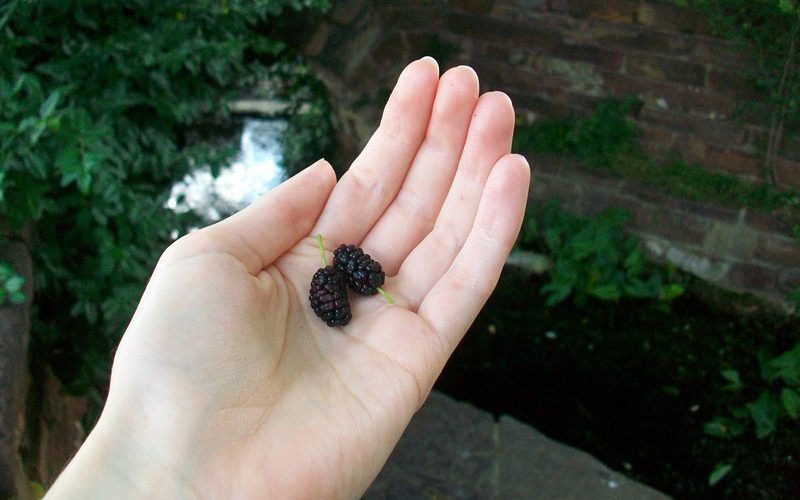By Amanda Bancroft
It’s mulberry season! The mulberry trees are producing delicious berries all over Fayetteville, and you can find them in surprisingly convenient locations. Look along the bike trail for telling signs, like smashed berries on the pavement or flocks of birds gathering in the branches to devour the fruit (but be careful: food that’s safe for birds is not necessarily safe for human consumption). Besides the bike trail, there’s a mulberry tree near Dickson St. across the street from the Walton Arts Center in the parking lot near the koi pond. It’s fun and relaxing to visit with the fish while munching mulberries. Another mulberry tree is not far away, on Block St. directly across from the Curious Book Shoppe.
Gathering wild edibles should be done with care. “When in doubt, leave it out,” is a good way to remember that if you can’t identify something, don’t risk eating it. Pick up a Wild Edibles guidebook or pocket brochure from a state park, conservation center, your local library, or used bookshop. If the plant could be poisonous, it’s best to have an expert ID it with you – take pictures and collect samples first. Be sure to avoid areas that have been sprayed with herbicides such as polluted areas near highways. Only harvest edibles from plants that look healthy, and go for younger leaves to avoid bitter-tasting older leaves.
Some local wild edibles to look for on your self-guided tour include the common sunflower (found later in summer), red mulberries, dandelions, wild strawberries, blackberries, raspberries, pawpaw, blueberries, huckleberries, walnuts, acorns, cattails, watercress, white clover, various mushrooms, and lamb’s quarters. Not everything you find will be native, but this list includes species able to be found in Northwest Arkansas.
A great example of a wild edible working for you is the common dandelion. It’s considered a lawn weed, so most people don’t want it growing in their yard. If you know your lawn is organic and unpolluted, you can harvest these “weeds” and use their flowers, leaves and roots. You may prepare them raw or cooked, and the leaves are often used in tea. Select young, tender leaves for tea and wash them thoroughly, then dry them out. Use one teaspoon dried dandelion leaves per one cup boiling water with your choice of lemon or honey. The flowers can even be used in wine making, which is a much better way to whine about dandelions.
Gathering wild edibles is a step closer to natural living, going beyond organic gardening to link us directly to the earth like any squirrel or rabbit. If you’re ready to venture out and begin foraging, pick up a field guide such as Edible Wild Plants: A North American Field Guide to Over 200 Natural Foods by Thomas Elias and Peter Dykeman. For an online guide to wild edibles, including delicious recipes, visit: www.wildedible.com










